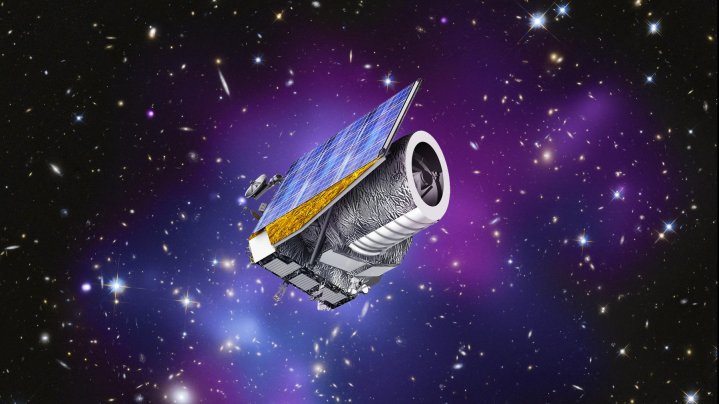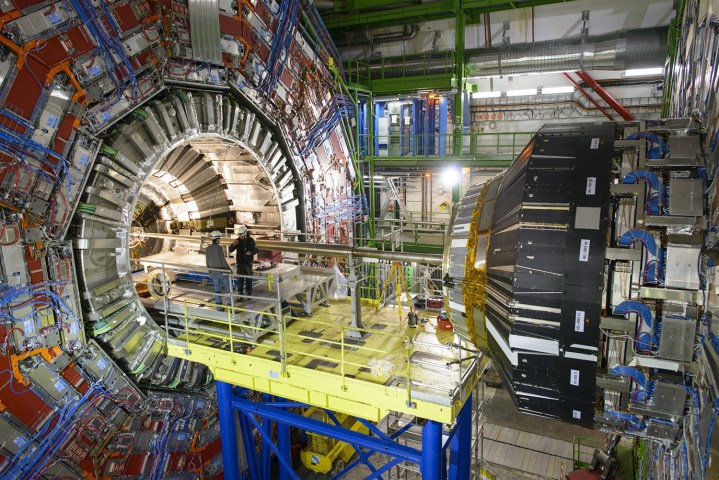
The single biggest question in physics today, and in arguably all of science, is seemingly a simple one: What is the universe made of? The answer to that only seems obvious until you learn that everything we see around us — every object, every speck of dust, every particle — makes up just 5% of all that exists. This ordinary matter is by far in the minority, and the rest of the universe is 27% dark matter and 68% dark energy.
“Dark matter is most of all matter. It’s everywhere, and it’s lurking in the darkness,” cosmologist Alex Hall of the University of Edinburgh told Digital Trends. “It’s this very fundamental mysterious thing that’s just not understood.”
We know that this dark universe must exist because of the movements of galaxies, but we can’t see it and can’t touch it. You might think that would make researching dark matter next to impossible, but in fact, we’re getting closer to understanding this hidden world than ever before.
Undergirding the structure of the universe
Dark matter isn’t just floating around filling up empty space. Importantly, it is found in clumps and structures, similar to ordinary matter. It forms the structure onto which ordinary matter gloms and is thought to be responsible for the structures of galaxies and the universe as a whole.
“We know that galaxies form in the scaffold that dark matter produces,” astronomer and early universe researcher Steve Wilkins of the University of Sussex explained. “It is an integral part of our universe to explain what we see.”
“We don’t have a firm theoretical handle on what dark matter should be.”
That’s because of dark matter’s gravitational effects, so a clump of dark matter will attract more dark matter to it — and it will attract ordinary matter as well. As stars require dense clouds of gas to form, they tend to form in regions with lots of dark matter.
So dark matter really drives the formation of stars, and therefore galaxies, both throughout the history of the universe and in terms of the new galaxies forming now. “The presence of dark matter really does shape today’s galaxies,” Wilkins said.
Drawing a map of the unknown
As important as dark matter is, actually studying the topic is challenging because it doesn’t interact with matter or light the way that other particles do.
“We don’t really know quite what it is that we’re looking for,” Hall said. “So it’s hard to design the perfect experiment to do this because we don’t have a firm theoretical handle on what dark matter should be.”
However, while we might not be able to directly detect dark matter, we can see where it is located due to its gravitational effects. So one of the primary methods for researching it right now is mapping out its location, with the aim of seeing how dark matter is distributed throughout the universe.
That’s the aim of the European Space Agency’s recently-launched Euclid mission, which Hall and Wilkins both work on. A space telescope built with extremely high levels of precision, it is currently on its way to the L2 orbit around the sun, from where it will be able to observe distant galaxies without having to deal with glare from the sun or distortions from Earth’s atmosphere. The goal is to create a 3D map of how dark matter is distributed across the universe.

Euclid will use two main methods to locate dark matter: gravitational lensing and galaxy clustering. Gravitational lensing, or weak lensing, is the same method used by telescopes like James Webb or Hubble to investigate extremely distant objects. It relies on the fact that a massive enough object will actually bend space-time, bending light coming from behind it and acting like a magnifying glass.
But while Webb or Hubble use this effect to look at the bent light coming from very distant background galaxies as a way of studying objects too distant to be observed otherwise, Euclid will use it in a different way. By seeing how much space-time is distorted by a foreground object like a galaxy, we can infer how much dark matter must be present in that foreground galaxy.
Inferring the invisible
The problem is that even though there is a lot of dark matter in the universe, “the effects that it has on normal matter is quite subtle,” Hall said.
So the effects of gravitational lensing are very small, with a change of around 1% to the shape of the galaxy. To measure this effect in a meaningful way requires both a large number of galaxies to be imaged, and acquiring very precise images. That’s why Euclid is performing a very wide survey of the sky and why it needs to be in space to minimize distortions.
“Where there’s lots of dark matter, you tend to get more galaxies.”
The other method used by Euclid to investigate dark matter, galaxy clustering, is a less direct measurement of dark matter but a stronger effect. By mapping out the locations of galaxies in three dimensions, you can infer where the dark matter will be located, roughly speaking. That’s because the regular matter in galaxies traces out the location of dark matter, “so where there’s lots of dark matter, you tend to get more galaxies,” Hall explained.
Once Euclid’s survey is complete and the data has been analyzed, in around ten to twelve years’ time, we should have a map of the universe’s dark matter and be able to see how that distribution has changed over time.
One step at a time
Having a map of dark matter might be neat, but how does it help with understanding what dark matter actually is? For the next step in the investigation, we need supercomputers.
The main way that astronomers, who take observations, and theorists, who come up with possible explanations of dark matter, work together is through the use of models. Researchers can use computing power to run simulations of the universe, seeing how it might appear if different theories of dark matter were correct.
What does the universe look like if dark matter is heavy, or light? How about if the dark matter is hot, warm, or cool? Powerful supercomputers can calculate how these different factors would change the distribution of dark matter across the universe, then we can compare these simulations with the observations of the universe as we actually see it.
None of the models we’ve come up with so far have been the perfect fit, but the data we’re collecting now will allow us to rule in or out whole classes of theories of what dark matter could be.
Finding the elusive particles
The other big and active avenue of dark matter research currently is searching for the particles that it could be composed of. Most researchers think that dark matter is probably a particle of some kind, though we don’t know what that particle could be.
Particle physics facilities like the Large Hadron Collider (LHC) are capable of smashing particles together to create short-lived exotic particles, any one of which could be candidates for dark matter.

Although these experiments haven’t yet found a candidate particle for dark matter, they have ruled out classes of particles. And researchers at CERN, the group which runs the LHC, are particularly interested in an approach called supersymmetry, which is an extension of the standard model of particles where each standard particle has a partner of a different mass. If found, these particles could help create a grand unified theory of physics and to explain dark matter.
Finally, another way to try to understand dark matter is to look at its interactions. Dark matter doesn’t interact with ordinary matter but some researchers think it could interact with itself, so it might be possible to detect some kind of radiation created by this self-interaction. “They’ve not found anything, but their statistical precision and their understanding of these experiments and the limits that they can put on these things is improving all the time,” Hall said.
Pushing the boundaries of knowledge
As daunting a task as it may be to chip away at the outskirts of a deeply mysterious phenomenon, researchers must approach it as best they can with the tools currently available to them — and do so with humility and cooperation.
“This is a big problem in physics, and it has to be tackled in small steps,” Hall said.
As gratifying as it would be to discover the dark matter particle tomorrow, in reality, the current research into dark matter is less like an Earth-shaking eureka moment and more comparable to brushing away dirt to reveal an artifact on an archeological dig. Teams of researchers work to eliminate one idea at a time, ruling out incorrect theories to get slowly closer to the truth.
We as humans want to know more about nature, about the universe, and about the world around us.”
“That’s how science progresses,” Hall said. “You discard theories and eventually you narrow in on something that you believe is a truthful depiction of nature.”
In the last decade, both technological improvements such as faster computing processors and new telescopes, as well as theoretical developments have driven dark matter researchers further than ever before, with researchers chipping away at a huge mystery.
As difficult as the problem of dark matter is, that’s part of what makes it so exciting for researchers. “I think we as humans want to know more about nature, about the universe, and about the world around us,” Hall said. “Having that understanding enriches all of our lives.”
Editors' Recommendations
- See the stunning first images taken by the dark matter-hunting Euclid telescope
- NASA map shows where you can see a solar eclipse across the U.S.
- Researchers come up with new method to ‘see’ dark matter
- Dark matter might be even stranger than we thought, according to Hubble
- SpaceX nails another launch and landing, but can’t catch the nose cone




